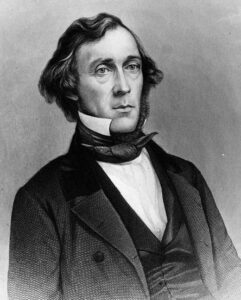Education as the Engine of Progress

Lewis H. Morgan School No. 37, Rochester, N.Y., 1935. Courtesy of the Rochester Public Library Local History & Genealogy Division.
Lewis Henry Morgan devoted much of his life to expanding educational opportunity, especially for people on the margins of society, including women and members of the working class. He also supported formal schooling for Native Americans. This devotion was consistent with Morgan’s larger philosophy of social evolution and his belief that all people had the ability to advance, both materially and mentally.
Cayuga Academy and the New York State Normal School at Albany
Morgan never imagined cultural autonomy or political sovereignty for Native people and nations. Instead, he hoped that Native people would assimilate into white American society. Morgan viewed education as the primary tool for this assimilation, and he proposed that Christian mission schools be established on reservations in order to educate young Native Americans.
In 1845, Morgan arranged for his friend and collaborator Ely S. Parker to attend Cayuga Academy in Aurora, New York, where Morgan himself had studied. Later, Morgan organized a group of sponsors to pay for two Tonawanda Seneca women—including Ely Parker’s sister, Caroline—to be educated at Cayuga Academy. In 1850, Morgan lobbied the New York State Regents in support of a bill that would provide scholarships for “a limited number of Indian youths” at the State Normal School in Albany, from which Caroline Parker graduated.
Barleywood University and Wells College

Tablet commemorating the centennial of Morgan’s birth. Still on display at Wells College, where Morgan served as a trustee. Rochester Historical Society, Publication Fund Series 2 (1923).
Morgan was committed to the education of women. In 1852, along with a number of other prominent Rochester businessmen, Morgan attempted to found Barleywood University, a college devoted exclusively to female education. Morgan firmly believed that “There is no good reason why female education should not be as thorough, as systematic, and also as cheap as it is in our colleges.” As Secretary to the Board of Trustees of Barleywood, Morgan obtained land for the university and organized a large list of sponsors.
Azariah Boody offered to donate a parcel of land called “Pitkin’s Woods” to Barleywood University. For reasons still not completely known, Barleywood failed to move past the planning stage, and in 1853, “Pitkin’s Woods” became the site of the University of Rochester’s first campus on Prince Street. Although Barleywood ultimately proved unsuccessful, Morgan served as a founding member on the Board of Trustees of Wells College, a women’s college established in 1868 in his hometown of Aurora.
University of Rochester
Morgan is intimately connected with the establishment of the University of Rochester. As an attorney, he represented the board of trustees and obtained the school’s permanent charter from the Regents of the State of New York in 1851. At the university’s first commencement, Morgan was given an honorary degree to recognize his help in founding the institution. Upon his death in 1881, Morgan left much of his estate and his entire personal library to the University of Rochester “for the purpose of female education of high grade in the City of Rochester.”

Women’s Residence Halls, River Campus, University of Rochester, ca. 1959. Courtesy of Rare Books, Special Collections, and Preservation, Rush Rhees Library, University of Rochester.
The University of Rochester, however, did not receive Morgan’s bequest until 1909, after the admission of women began in 1900. A wing of the Women’s Residence Hall at the University of Rochester was named in honor of Morgan when the building opened in 1955. The building is now known as Susan B. Anthony Hall.


